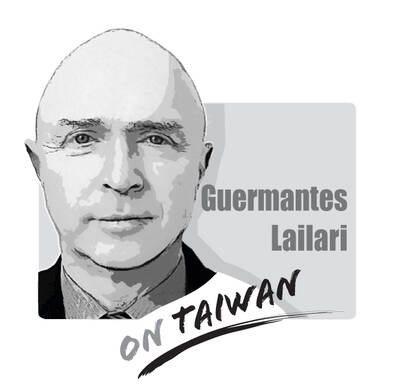When Chinese Nationalist Party (KMT) Legislator Chiang Wan-an (蔣萬安) last month suggested that Chiang Kai-shek Memorial Hall be renamed the “Taiwan development memorial hall,” the idea did not emerge out of a vacuum.
The hall, which commemorates Chiang Kai-shek (蔣介石) of the KMT, is a symbol that the party faithful would not want to see desecrated. Although Chiang Wan-an’s idea was largely ignored at the time, he was trying to put the party in the driving seat of a process that is going to happen anyway. The Transitional Justice Commission on Sept. 28 last year announced its intention to transform the hall and remove the central statue of Chiang Kai-shek.
This process coincides with another initiative to transform a major symbol: Legislative Speaker You Si-kun (游錫堃) last month announced plans to visit 19 possible sites for relocation of the Legislative Yuan.
Since 1960, the legislature has been at the site of the former Taipei Municipal Zhongshan Girls High School, which was constructed during the Japanese colonial era. Perhaps this choice was indicative of the then-KMT’s party-state’s derisive attitude regarding the rule of law. Perhaps it said more about Chiang Kai-shek’s expectation of returning his government to its “rightful” seat in China.
However, Taiwan is a different place now and moving the legislature is long overdue.
This is where a suggestion by Lee Hsiao-feng (李筱峰), an honorary professor at National Taipei University of Education, comes in: Why not move the legislature to the memorial hall site?
The memorial sits on one end of a huge expanse of land on prime real estate in the middle of the nation’s capital, a stone’s throw from the Presidential Office building. It is high on the list of Taipei’s tourist destinations. Even if an international visitor had no interest in the hall itself, it looms large at the end of the same park that houses the National Concert Hall and the National Theater, which face each other across Liberty Square. The message it was designed to convey is problematic in post-democratization Taiwan.
Lee’s solution is certainly attractive, as the hall is easily accessible to transport; Liberty Square is suitable for gatherings, petitions and protests without affecting traffic; it has a spacious interior; the state already owns the land; and repurposing the hall would solve the transitional justice issues it represents.
Some might have concerns over the clearly Chinese architectural elements of the buildings, but these could also be regarded as anchoring it within Taiwan’s complex colonial history, as do the Japanese colonial era Presidential Office building and the National Palace Museum built under the post-Chinese Civil War KMT regime. These disparate architectural styles could also be seen as a celebration of the rich historical tapestry that has formed modern Taiwan.
The grand, impressive structure in its majestic surroundings might also enhance legislators’ understanding of the somber nature of their duty, and perhaps even prompt them to behave like adults when debating policies.
These considerations address the ideological and practical issues, but what would the public think?
Liberty Square is a large public expanse and a popular destination for residents. If the hall were repurposed as the Legislative Yuan, would the square need to be cordoned off? Would protests, demonstrations and security measures impede the enjoyment of visitors to the National Theater and National Concert Hall? Would supplementary government buildings, annexes and wings be built around the hall, marring the optics and upsetting the symmetry of the grounds?
If You does take up Lee’s suggestion, implementation would be the key.

There is much evidence that the Chinese Communist Party (CCP) is sending soldiers from the People’s Liberation Army (PLA) to support Russia’s invasion of Ukraine — and is learning lessons for a future war against Taiwan. Until now, the CCP has claimed that they have not sent PLA personnel to support Russian aggression. On 18 April, Ukrainian President Volodymyr Zelinskiy announced that the CCP is supplying war supplies such as gunpowder, artillery, and weapons subcomponents to Russia. When Zelinskiy announced on 9 April that the Ukrainian Army had captured two Chinese nationals fighting with Russians on the front line with details
On a quiet lane in Taipei’s central Daan District (大安), an otherwise unremarkable high-rise is marked by a police guard and a tawdry A4 printout from the Ministry of Foreign Affairs indicating an “embassy area.” Keen observers would see the emblem of the Holy See, one of Taiwan’s 12 so-called “diplomatic allies.” Unlike Taipei’s other embassies and quasi-consulates, no national flag flies there, nor is there a plaque indicating what country’s embassy this is. Visitors hoping to sign a condolence book for the late Pope Francis would instead have to visit the Italian Trade Office, adjacent to Taipei 101. The death of
By now, most of Taiwan has heard Taipei Mayor Chiang Wan-an’s (蔣萬安) threats to initiate a vote of no confidence against the Cabinet. His rationale is that the Democratic Progressive Party (DPP)-led government’s investigation into alleged signature forgery in the Chinese Nationalist Party’s (KMT) recall campaign constitutes “political persecution.” I sincerely hope he goes through with it. The opposition currently holds a majority in the Legislative Yuan, so the initiation of a no-confidence motion and its passage should be entirely within reach. If Chiang truly believes that the government is overreaching, abusing its power and targeting political opponents — then
The Chinese Nationalist Party (KMT), joined by the Taiwan People’s Party (TPP), held a protest on Saturday on Ketagalan Boulevard in Taipei. They were essentially standing for the Chinese Communist Party (CCP), which is anxious about the mass recall campaign against KMT legislators. President William Lai (賴清德) said that if the opposition parties truly wanted to fight dictatorship, they should do so in Tiananmen Square — and at the very least, refrain from groveling to Chinese officials during their visits to China, alluding to meetings between KMT members and Chinese authorities. Now that China has been defined as a foreign hostile force,